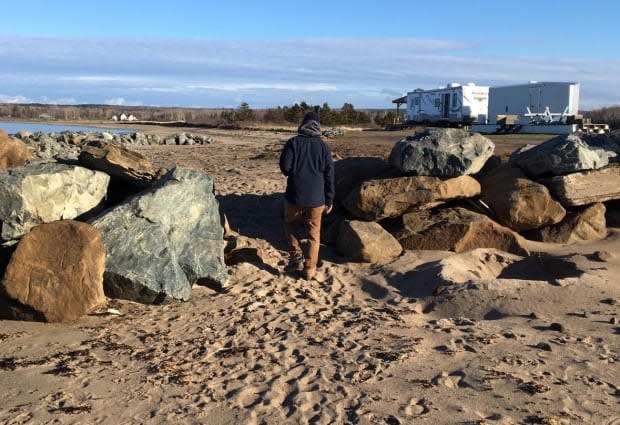Pictou County beachgoers win right to challenge minister's decision
A Nova Scotia judge has decided that a case of beach access, erosion and property rights will go ahead despite the province's attempts to have it thrown out.
A decision from Justice Ann Smith of the Nova Scotia Supreme Court was released Friday in the case of beachgoers concerned with the province's stance on an armour stone wall built across James Beach in Pictou County.
"We're very pleased to hear that," said Maryn Lynn, one of the applicants in the case along with her mother, Sandra. "We're going to have our day at court."
She has a family cottage on the sandy shore, also known as Black Point Beach, and spent the past 22 years walking it with her parents. She does the same now with her son.

Lynn and others brought their concerns about the rock wall, which now reaches across the beach and into the ocean during high tide, to the Department of Lands and Forestry earlier this year.
She said heavy construction equipment on the beach endangers the piping plovers that nest there, and no one should be allowed to build anything below the high-water mark on public beaches since it's considered Crown land.
Wayne and Helen Chisholm built the rock wall at the beach, northeast of New Glasgow, in 2017. The Chisholms say they added to the wall earlier this year after a bad storm in November 2018 washed some of it away, along with a chunk of their property.
Protection from tides, storms
Wayne Chisholm told the CBC in June that he needs the wall to protect his property from rising tides and powerful storms. The coastal property has been in his wife's family for nearly 200 years.
He said he's only added rocks to the wall to reclaim the land he lost in the 2018 storm. He estimates he's spent well over $40,000 on the project.
"What I suggest you do is talk to the [Department of Lands and Forestry] and they will verify that the rocks are legal and they're on our land and so be it," he said. "That's it."
But in May, two emails were sent to the province about new material being dumped on the beach around the rock wall. One was from Sandra and the other from Beth Skerrett, a fellow beachgoer and applicant.
A public email campaign was also started by the Black Point Beach Preservation Group, which has more than 500 members on Facebook. The community also put together a crowdfunding campaign that raised over $15,000 to cover legal expenses.
Iain Rankin, former Lands and Forestry minister, emailed Skerrett back in June. He said staff visited the site and found the wall is perfectly legal because it's on private property.

"In 2017, erosion control work was undertaken on James Beach. No permits were required, as the work was within the boundaries of private land, above the mean high-water mark. In addition, no work was done on submerged Crown land," Rankin wrote to Skerrett.
But the applicants say this email is a "decision" that they want to undergo a judicial review. They say it's contrary to the Nova Scotia Beaches Act, the Crown Lands Act and the Endangered Species Act.
New complaint, according to judge
While staff had indeed reviewed photos and construction work done as of January on the wall and determined it was within the Chisholm land boundary, Smith wrote in her decision that the May emails were actually a new complaint.
She wrote that there was "no evidence" before the court that any provincial staff had visited the Chisholm property after the May complaints, despite being sent new photos.
The province asked the Supreme Court on Sept. 15, 2020 for decisions on this matter, including whether the applicants filed on time, and whether the review should be dismissed because the applicants lacked either private or public interest standing.

Although the province argued the applicants' notice was filed too late based on the January correspondence, Smith said the relevant date is Rankin's June email, so everything was on time.
Smith also determined the applicants have private interest standing, since, as property owners in the vicinity to the Chisholm property, they have a greater interest with respect to the activities there than other Nova Scotians.
"James Beach may be just another beach, but for them, the shoreline is where they grew up and shared with their children and grandchildren over the years," Smith said.
The decision also approves Wayne Chisholm's request for intervener status in the upcoming judicial review, set for January 2021.
Opening in the wall
The Chisholms have added an opening in the wall for people to pass through at high tide, but Lynn said that doesn't solve the problem.
Given climate change, the issue of coastal erosion washing away land and moving the high water mark will only become more and more prevalent around the province, Lynn said.
"I want them to have a real good look about how we regulate structures that are put on beaches to protect private properties," Lynn said.
She added she isn't against landowners putting up protective barriers as long as they're not putting public access to the beach at risk, endangering habitats, and staying above the ordinary high-water mark.
A spokesperson for the Lands and Forestry department said Monday they are are not able to comment at this time, as the matter is before the courts.
MORE TOP STORIES


